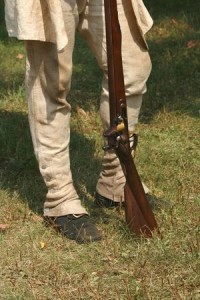If you’ve been around the Revive 1775 blog for a while, you know the incredible story of April 19th, 1775.
Or at least you know the overarching story. But the life of the story is in the details. Wouldn’t you agree? When I’m invited by a group to tell the story, the first thing I do is find out how much time I have. I can do a good overview in twenty minutes. But give me an hour and a half and you’ll come away inspired by what those people went through that day.
I’m a Daughter of the American Revolution. In this great organization, one of our missions is to tell the stories of our Patriots – our brave ancestors who participated in the Revolutionary War on the American side. These stories, for the most part remain shrouded in the fog of years long ago.
But there’s another group of men and women – those who fought bravely for the liberty of the next generation but had no descendants to honor them.
There were so many. Today, I’ll tell you just one of those stories.
 Nathaniel Mulliken. Clockmaker. Lexington, MA.
Nathaniel Mulliken. Clockmaker. Lexington, MA.
Nate was named after his father , who was the Lexington clockmaker before his death in 1767. The senior Nathaniel left a wife, four sons and three daughters behind. Nate took over the clock shop next to their home. It was two doors from Monroe Tavern on the main road from Boston to Concord.
At age 23, Nate was now the man of the family. He was responsible for caring for his mother and younger siblings. I’m certain he took that role of provider seriously. 
In the pre-dawn of April 19th – it was a Wednesday morning, Nate joined the Lexington training band on the town green, after having been warned that the Regulars were out. The Redcoats – eight hundred of his Majesty’s best, were marching to Concord to confiscate the munitions stored there. It wasn’t the first time they’d tried this, but it was definitely the most ambitious to date. The secondary mission of the King’s soldiers was to arrest Sam Adams and John Hancock, who were staying in the Reverend Clarke’s home in Lexington.
Nate joined seventy other men on the Green that morning. And by the time the Redcoats left Lexington to continue their march to Concord, eight men lay dead on the Lexington Green, more wounded. The tiny town of seven hundred souls heard the victory volley and three cheers before Colonel Smith marched his forces out of town.
The people in Lexington knew that the regulars would be back through later. They scrambled to bury their dead in a mass grave. Captain Parker, Nate’s commander gathered his forces and they, too, marched out of town toward Concord.
At a prime spot for an ambush, Nate and his brothers in arms waited. At about two o’clock that afternoon, they would have a measure of revenge. Captain Parker’s men would open fire on Smith and his troops and continue firing until they could no longer safely hold that position. Then they would take to the woods, joining thousands of other militia fighters as they circled ahead of the Redcoat army, ambushing them over and over again until the Redcoats finally made it back to Boston.
Nate would return home to Lexington to find his home and shop burned to the ground.
The search of the body of a dead Redcoat would turn up items stolen from the shop before it was torched.
Nate would leave for Boston, to join the Revolution, probably the next morning. And less than two years later, Nate would die of camp fever at the age of twenty-five.
When they pledged their lives and their fortunes, these men—young and old—knew what they were saying. They were willing to pay that price – even if they never saw the liberty for which they sacrificed.

